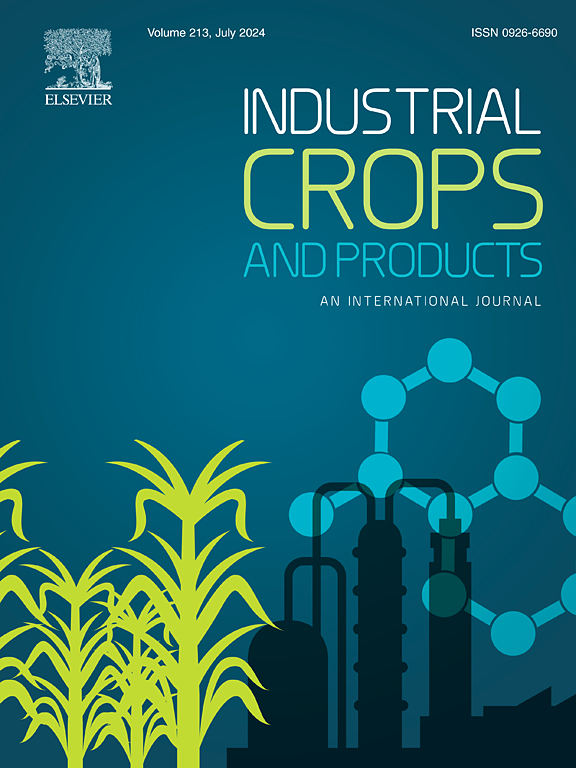通过分子模拟筛选聚丙烯天然抗氧化剂并阐明其抗氧化机理
IF 5.6
1区 农林科学
Q1 AGRICULTURAL ENGINEERING
引用次数: 0
摘要
聚丙烯(PP)在实际应用中容易发生氧化降解,从而大大限制了其使用寿命。本研究将多尺度模拟技术与实验验证相结合,从45种天然酚类化合物中系统筛选和鉴定出高效抗氧化剂,同时阐明了它们减轻PP热氧化降解的潜在保护机制。分子动力学(MD)和蒙特卡罗(MC)模拟。溶解度参数(δ)分析表明,百里香酚、丁香酚和香薰醇与PP的相容性最高,其中百里香酚的δ差异最小(1.366 (J·cm-³)¹/²)。模拟结果表明,百里香酚具有较高的键解离能(BDE: 163.728 kJ/mol)、较低的扩散系数(D)(0.0112 × 10- 26 cm²/s)、较低的渗透系数(P)(1.493 × 10-⁹cm²·s -¹·kPa-¹)和较低的反应能势阱,具有较好的吸附自由基能力,具有长期稳定和高效的性能。采用x射线衍射(XRD)、x射线光电子能谱(XPS)、差示扫描量热法(DSC)、熔体流动速率(MFR)测量、力学性能表征和氧化诱导时间(OIT)测定等先进分析技术,通过热氧化老化实验系统验证了百里香酚的最佳抗氧化效果。DSC结果表明,PP的熔融温度提高了2.9 °C, XRD数据表明结晶度增强。XPS测定表明,百里香酚在老化后的氧碳比(n(O)/n(C))变化最小(47.13 %)。力学测试表明,百里香酚/PP在老化5 d后的断裂伸长率为62.73 %,明显优于纯PP (3 d后失效)和其他抗氧化体系。百里酚使PP的油脂含量增加了173.86 %。该研究为聚丙烯环保型抗氧化剂的开发提供了坚实的理论基础和实践指导。本文章由计算机程序翻译,如有差异,请以英文原文为准。

Screening natural antioxidants for polypropylene through molecular simulation and elucidation of their antioxidant mechanisms
Polypropylene (PP) is prone to oxidative degradation during practical applications, thereby significantly limiting its service life. The present study integrates multiscale simulation techniques with experimental validation to systematically screen and identify highly effective antioxidants from 45 natural phenolic compounds, while elucidating their underlying protective mechanisms in mitigating the thermo-oxidative degradation of PP. The O-H bond dissociation energy (BDE), molecular mobility, and oxygen barrier properties were comprehensively evaluated through a combination of quantum mechanics (QM), molecular dynamics (MD) and Monte Carlo (MC) simulations. Solubility parameter (δ) analysis showed that thymol, eugenol, and carvacrol exhibited the highest compatibility with PP, with thymol showing the smallest δ difference (1.366 (J·cm-³) ¹/²). Simulations demonstrated that thymol possesses outstanding free radical trapping ability, as evidenced by its relatively high bond dissociation energy (BDE: 163.728 kJ/mol), along with a low diffusion coefficient (D) (0.0112 × 10-⁶ cm²/s), low permeability coefficient (P) (1.493 × 10-⁹ cm²·s -¹·kPa-¹), and a reduced reaction energy barrier, indicating long-term stability and highly efficient. The optimal antioxidant efficacy of thymol was systematically validated through thermo-oxidative aging experiments, employing advanced analytical techniques including X-ray diffraction (XRD), X-ray photoelectron spectroscopy (XPS), differential scanning calorimetry (DSC), melt flow rate (MFR) measurement, mechanical property characterization, and oxidation induction time (OIT) determination. DSC results showed a 2.9 °C increase in PP melting temperature, supported by XRD data indicating enhanced crystallinity. XPS measurements indicated that thymol exhibited the minimal alteration (47.13 %) in the oxygen-to-carbon (n(O)/n(C)) ratio following aging. Mechanical testing showed that thymol/PP retained 62.73 % elongation at break after 5 days of aging, significantly outperforming pure PP (failure after 3 days) and other antioxidant systems. OIT tests revealed a 173.86 % increase in PP's OIT value with thymol. This study provides a robust theoretical foundation and practical guidance for developing eco-friendly antioxidants for PP.
求助全文
通过发布文献求助,成功后即可免费获取论文全文。
去求助
来源期刊

Industrial Crops and Products
农林科学-农业工程
CiteScore
9.50
自引率
8.50%
发文量
1518
审稿时长
43 days
期刊介绍:
Industrial Crops and Products is an International Journal publishing academic and industrial research on industrial (defined as non-food/non-feed) crops and products. Papers concern both crop-oriented and bio-based materials from crops-oriented research, and should be of interest to an international audience, hypothesis driven, and where comparisons are made statistics performed.
 求助内容:
求助内容: 应助结果提醒方式:
应助结果提醒方式:


